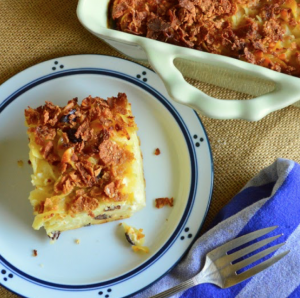A dish that is of great importance to my family is Kugel. The translation of Kugel from its German origin to English is ‘ball’ or ‘sphere’. While this English definition seems completely awry from the dish I have come to know today, the root of the name represents the original sphere-like shape that Kugel was once served as. Today, my grandmother makes kugel in a large eleven by fifteen Pyrex dish in order to accommodate my growing family. Kugel is a noodle casserole that can be served as either a savory or sweet dish depending on the chef and the family tradition. My family traditionally makes sweet kugel which includes a noodle pudding base fused with raisins, sprinkled with brown sugar and crushed graham crackers. This compares to a savory kugel which might include onions, potatoes, and cornflakes in addition to the staple noodle casserole base. This dish is significant to my family as its unique recipe has been passed down for generations. This dish is so special that only those with the family touch are able to replicate it. The same rings true for other dishes passed down through generations such as our sour cream coffee cake. My aunt, who is not blood-related to my grandmother, has never been able to replicate the true taste of our family’s kugel or coffee cake. It is for this reason that we say you must have the Fireman family touch in order to recreate these family recipes. Historically, kugel is a dish made by Ashkenazi Jews, traditionally served at Jewish holidays which embody celebration. As the dish is passed through each side of my family, individually, the number of holidays kugel is served at expands but the hidden meaning behind the dish of celebration holds true throughout each sweet slice.
Kugel is one of my favorite dishes because it reminds me of my family. My grandmother’s famous sweet noodle kugel represents extended family gatherings. The smell of crushed graham crackers and brown sugar sprinkled on crisp yet creamy noodles induces memories of Thanksgiving, Rosh Hashana, Yom Kippur, Hanukkah, Birthdays and those special times that she would surprise us with an unexpected noodle kugel. I like this dish not only because of its significance to my family but also because of the different flavors the dish offers. With four cavities and counting this year alone, you could say that I have an unusually large sweet tooth. I constantly crave sugar, so anything sweet that is served at dinner is extremely appealing to me. The creamy texture of the layers of noodles pairs perfectly with the crispy top. The savory taste of the noodles combines so well with the raisins swirled evenly into the kugel and sprinkled on the top. To top it off, the crushed graham cracker mixed with brown sugar coating the outer layer of the noodle pudding is what makes the entire dish. Once everyone has stuffed themselves with enough of Grandma’s noodle kugel, my cousin, Samantha, and I routinely proceed to pick the toppings off the top of the kugel. The top is the best part because it is the sweetest and the crunchiest. Psychologically, we crave crunchy foods over soft foods as it is an indicator of freshness so it is no question that my cousin and I crave the sweet and crispy topping of the noodle kugel even after stuffing ourselves with my grandmother’s notorious cooking.
Kugel is connected to both sides of my family, tracing back through our Jewish history. The first kugels were made savory with potatoes and onions to induce a greater flavor. However, once sugar becomes more of a staple in the 17th century, Jews in Poland were among the first to diverge towards a sweeter dish. This would explain why my family favors the sweet version of kugel as my great grandmother moved to The United States from Poland. At just six years old, my Bubbe arrived in the states carrying only her most valuable belongings, one of which included her famous kugel recipe. In most Jewish households, kugel is a dish commonly served on Shabbat. Shabbat, the Jewish Sabbath, is celebrated Friday nights until sundown on Saturday nights as a day of rest to appreciate ourselves, the people around us, and God. Shabbat represents a time of fulfillment and what better way to celebrate this than with kugel. Deeper than this, however, kugel resembles a dish made as early as 50 C.E. referred to as pashtida. It is said that the different layers and features of pashtida symbolize the manna. The manna was the food provided to the Israelites while wandering in the desert after forty years of enslavement in Egypt. The story tells of the manna being provided by the heavens every day except on Saturday, which is now known as Shabbat. Every Friday, just before Shabbat began at sundown, the manna provided would be sweeter than previous days. It was because of this that Friday at sundown until Saturday at sundown became known as Shabbat. The structure and, for some, the sugar within kugel represents the manna which signaled Shabbat. It is for this reason that we serve kugel on Shabbat, the holiest day of the week in Judaism. This includes all other celebrations on the Sabbath such as bar and bat mitzvahs. While my family has extended the meaning of kugel from the Sabbath to all family celebrations, the true meaning of joy and happiness that is baked into the sugary noodle dish remains constant through every family gathering that kugel is served at by my grandmother.

Source: www.thisishowicook.com
“Not my Mama’s Noodle Kugel or Finally, the Daughter Likes it!” by Abbe Odenwalder Published on October 6th, 2014

Above is a photo of my extended family on my mom’s side, pictured at Thanksgiving this past November (2018). My Grandma Phyllis is seated next to me (Third down on the right).
Grandma Phyllis’ Famous Noodle Kugel Recipe:
Ingredients:
8 oz medium noodles
1/4 cup butter
1/4 lb cream cheese
4 eggs
1/2 cup sugar
1 1/2 cups mils
1 tbs vanilla
Raisins
crushed graham crackers (about 7 whole ones crushed with a rolling pin)
Instructions:
Cook noodles and drain, then mix with 1/4 stick of butter
Mix cream cheese, sugar, add eggs one at a time add milk and vanilla
Fold in noodles and raisins
Put in buttered pyrex dish rectangular
Bake at 350 for 25 minutes until top is golden
Take crushed graham crackers, sugar (approximately less than a 1/4 cup), melted butter that has been melted in microwave (approximately 1/4 stick) and mix together. Put this on top of the pudding and bake another 30 minutes until it looks nice and crispy on top
Note: My Grandmother did not have a recipe written down, only the ingredients because she is the only one in my family who can replicate her famous kugel. She had to write down the instructions on the spot when I asked her for the recipe.
I learned more about the history of kugel from Chabad.org by reading the article “Why Eat Kugel on Shabbat?”
https://www.chabad.org/library/article_cdo/aid/3131238/jewish/Why-Eat-Kugel-on-Shabbat.htm

Julia, it was a delight to learn about your favorite dish, your grandma Phyllis’s kugel. Your introduction is intriguing; it draws your audience in while providing some background information about the dish. You have demonstrated your knowledge of different variations of kugel through detailed descriptions of both the sweet and savory versions. It’s interesting that you characterize the family connection with particular dishes as a “family touch.” I wonder if you could be more explicit about the influence your grandma’s kugel (or other signature family foods) has upon your self-conception. What impacts do you see these dishes have induced in you as a person over the years, especially now that you’ve started college and presumably lived away from your family. You’ve done a good job detailing the holidays and tastes of kugel, but I would encourage you to be more reflective of your relation to kugel. Good job on the research of the history of the dish. Last but not least, lovely family photo!